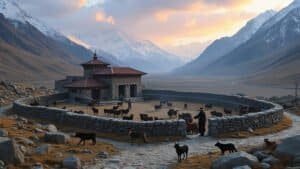Introduction
Snow leopards are one of the most elusive and endangered big cats in the world. However, their populations are under severe threat due to retaliatory killings by local communities
These killings occur when snow leopards prey on livestock, leading to economic losses for herders who often resort to killing the predators in retaliation
This article explores the root causes of retaliatory killings, their devastating impact on snow leopard populations, and the regions most affected. We will also examine the conservation efforts being implemented to protect these majestic animals and discuss the effectiveness of various preventative measures
Main Causes of Retaliatory Killings
Retaliatory killings of snow leopards are primarily driven by human-wildlife conflict, particularly in regions where pastoral communities rely heavily on livestock for their livelihood
These conflicts arise when snow leopards, facing dwindling prey populations in the wild, turn to domesticated animals as a food source. This section delves into the main factors that contribute to these retaliatory actions
Conflict Between Snow Leopards and Livestock
The most direct cause of retaliatory killings is the predation of livestock by snow leopards. In regions where traditional pastoralism dominates, livestock such as sheep, goats, and yaks are often left to graze in open, unsecured areas
Snow leopards, driven by hunger and the scarcity of their natural prey, occasionally attack these animals. Such incidents can devastate a herder’s livelihood, especially in remote areas where there is little financial safety net. For example, in some parts of Mongolia, a single snow leopard attack can wipe out a significant portion of a family’s livestock, leading to substantial economic losses
Studies have shown that snow leopards kill between 2% and 5% of the total livestock in areas where they overlap with human populations. This predation leads to immediate retaliation by herders, who may hunt or poison the snow leopard responsible
Research by the Snow Leopard Trust highlights that in regions like the Altai-Sayan mountains, nearly 55% of livestock owners admit to having killed a snow leopard in response to livestock losses (Snow Leopard Trust, 2020). This retaliatory behavior is a significant threat to the already vulnerable snow leopard population
Economic Pressures on Local Communities
The economic impact of livestock losses cannot be overstated. For many herders, livestock represents not just a source of income, but also a form of savings and security
In countries like Nepal, where alternative economic opportunities are scarce, the loss of even a few animals can push families into poverty. This financial strain often compels communities to take extreme measures to protect their remaining assets, including killing snow leopards
Furthermore, insurance schemes and compensation programs aimed at mitigating these losses are either poorly implemented or absent in many regions
According to a 2018 study published in Biological Conservation, the effectiveness of compensation schemes is limited by factors such as bureaucratic delays, insufficient funds, and lack of awareness among herders (Mishra et al., 2018). As a result, many herders see no other option but to eliminate the perceived threat to their livelihood, leading to an increase in retaliatory killings
Cultural Beliefs and Practices
In addition to economic factors, cultural beliefs and practices also play a role in the retaliatory killings of snow leopards
In some regions, there is a deep-rooted belief that killing a predator responsible for livestock losses is necessary to prevent future attacks. This belief is often passed down through generations, making it a deeply ingrained practice that is difficult to change
For example, in parts of Central Asia, traditional practices involve setting traps or poisoning carcasses to kill snow leopards that have preyed on livestock. These methods are often seen as a way to protect the community’s resources and are sometimes carried out with the support or tacit approval of local leaders
Changing these practices requires not only raising awareness about the importance of snow leopards to the ecosystem but also providing viable alternatives that can protect livestock without harming the predators
Additionally, in some cultures, there is a lack of awareness about the endangered status of snow leopards. In regions where these animals are still relatively common, there may be a perception that the population is stable and that killing a few individuals will not have a significant impact. This misunderstanding exacerbates the problem, leading to more frequent retaliatory killings
Overall, the main causes of retaliatory killings of snow leopards are deeply intertwined with the economic realities, cultural practices, and traditional beliefs of the communities that share their habitats
Addressing these issues requires a multifaceted approach that combines education, economic support, and community engagement to change attitudes and reduce the frequency of these killings
Impact on Snow Leopard Populations
The impact of retaliatory killings on snow leopard populations is profound and multifaceted, contributing significantly to the decline of this already endangered species
This section explores the direct effects of these killings on population numbers, the broader implications for genetic diversity, and specific case studies that illustrate the severity of the issue
Decline in Numbers and Regional Extinction Risks
Retaliatory killings are a major driver of the decline in snow leopard populations across their range
Estimates suggest that there are only between 3,500 and 7,000 snow leopards left in the wild, with the population continuing to decrease at an alarming rate. In areas where human-snow leopard conflict is prevalent, these numbers are even more precarious
A study by McCarthy et al. (2017) published in Global Ecology and Conservation indicates that the global snow leopard population may be declining by as much as 20% every two decades, primarily due to retaliatory killings and habitat loss. In some regions, these killings have pushed local snow leopard populations to the brink of extinction
For instance, in parts of Kyrgyzstan, where herding is a primary livelihood, snow leopard numbers have dropped by over 30% in the last decade due to increased retaliatory actions by herders
This decline not only threatens the survival of snow leopards in isolated regions but also impacts the species’ overall genetic diversity and ability to adapt to environmental changes. The loss of even a few individuals in a small population can have a disproportionately large impact, leading to reduced genetic variability and increased susceptibility to disease and other threats
Effects on Reproduction and Genetic Diversity
The impact of retaliatory killings extends beyond the immediate loss of individual snow leopards. These killings disproportionately affect breeding-age adults, which can have a devastating effect on the reproductive capacity of the population
Snow leopards have a slow reproductive rate, with females typically giving birth to only two or three cubs every two years. The loss of breeding adults reduces the number of potential offspring, further accelerating the population decline
Moreover, when populations become fragmented due to high mortality rates, it leads to isolated groups of snow leopards that have little genetic exchange with other populations. This isolation can result in inbreeding, which reduces genetic diversity and the overall health of the population
A study conducted by Janečka et al. (2019) and published in Conservation Genetics highlights that in regions with high levels of human-snow leopard conflict, genetic diversity is markedly lower compared to more stable populations
This reduction in genetic diversity weakens the species’ resilience to environmental changes and disease, making the long-term survival of snow leopards even more uncertain. It also affects their ability to adapt to shifting prey populations and changing habitats, further increasing the risk of extinction in certain areas
Case Studies of Population Declines Due to Killings
Several regions illustrate the stark impact of retaliatory killings on snow leopard populations. In the Pamir Mountains of Tajikistan, where herding communities face significant economic challenges, retaliatory killings have led to a dramatic decline in snow leopard numbers
According to a 2020 report by Panthera, an organization dedicated to wild cat conservation, the local snow leopard population has decreased by approximately 40% over the past 15 years due to retaliatory killings
Similarly, in the Indian state of Himachal Pradesh, where snow leopards are known to prey on livestock, government records show a 30% decrease in the snow leopard population over a decade. Efforts to mitigate this decline through compensation schemes have been partially successful, but the population continues to suffer due to ongoing conflicts with local herders
In Mongolia, the situation is equally dire. The Tost Mountains, a critical habitat for snow leopards, have seen a significant reduction in population due to retaliatory killings and habitat encroachment
Despite the area being designated as a protected nature reserve, illegal killings persist, driven by the lack of effective enforcement and economic pressures on local communities
These case studies underscore the urgent need for comprehensive strategies to address the root causes of retaliatory killings and to protect the remaining snow leopard populations. Without concerted efforts to reduce human-wildlife conflict and promote coexistence, the survival of snow leopards in many regions remains at risk
Regions Most Affected by Retaliatory Killings
Retaliatory killings of snow leopards occur across the entire range of this species, but certain regions are particularly affected due to high levels of human-wildlife conflict
This section examines the regions most impacted by these killings, highlighting the specific challenges faced by snow leopard populations in Central Asia, South Asia, Mongolia, and China
Central Asia: Kyrgyzstan and Tajikistan
Central Asia is one of the most affected regions, particularly in Kyrgyzstan and Tajikistan. These countries are home to a significant portion of the global snow leopard population, but also to many pastoral communities whose livelihoods depend on livestock
In Kyrgyzstan, for example, herding is a traditional way of life, and livestock losses to snow leopards can represent a major economic setback
Research by the Global Snow Leopard & Ecosystem Protection Program (GSLEP) in 2020 found that Kyrgyzstan experiences some of the highest rates of retaliatory killings in the world. The survey revealed that 60% of herders in key snow leopard habitats had lost livestock to snow leopards in the past year, with many admitting to having killed the predators in response
In the Alay and Tien Shan mountain ranges, where livestock grazing overlaps extensively with snow leopard habitats, these killings have led to a noticeable decline in local snow leopard numbers
Tajikistan faces similar challenges, particularly in the Pamir Mountains. This region is characterized by high-altitude pastures where herding is a primary economic activity
A 2019 study published in Cat News reported that retaliatory killings in Tajikistan have reduced snow leopard numbers by approximately 40% over the last two decades, with herders often using poisons or traps to eliminate perceived threats to their livestock
South Asia: India, Nepal, and Pakistan
In South Asia, India, Nepal, and Pakistan are key regions where snow leopards are at risk due to retaliatory killings. The rugged Himalayan terrain, which spans these countries, is a stronghold for snow leopards, but it is also an area where human populations and livestock are expanding, leading to increased conflict
In India, particularly in Himachal Pradesh and Jammu & Kashmir, the predation of livestock by snow leopards is a significant issue. The Wildlife Institute of India (WII) estimates that around 16% of the snow leopard population in these areas has been lost due to retaliatory killings over the past decade
The government has implemented compensation schemes to offset livestock losses, but delays and bureaucratic hurdles often frustrate herders, leading them to take matters into their own hands
Nepal, home to the Annapurna and Sagarmatha National Parks, has also seen a troubling rise in retaliatory killings
A 2021 report by the National Trust for Nature Conservation (NTNC) highlighted that nearly 30% of snow leopards killed in the country were a result of retaliatory actions by local communities. The Langtang and Manang regions, in particular, are hotspots for such conflicts
In Pakistan, the Karakoram and Gilgit-Baltistan regions have been identified as areas where snow leopards frequently come into conflict with livestock
A 2022 study published in Oryx found that retaliatory killings are responsible for the deaths of at least 10-15 snow leopards annually in these regions. Despite the presence of conservation programs, the high dependence of local communities on livestock and the lack of effective conflict mitigation strategies continue to pose significant challenges
Mongolia and China: Hotspots of Conflict
Mongolia and China are crucial to the survival of the snow leopard, as these countries host some of the largest remaining populations. However, both countries face severe challenges in managing human-wildlife conflict, leading to high rates of retaliatory killings
In Mongolia, the South Gobi region is a critical habitat for snow leopards, but it is also a region where herding is the primary occupation. The Snow Leopard Conservation Foundation (SLCF) has reported that in the Tost Mountains, a key snow leopard habitat, retaliatory killings have reduced the local population by 25% over the past decade
Efforts to protect these cats have been complicated by the region’s remoteness and the deep-seated cultural practices of herding communities, who often view snow leopards as a direct threat to their livelihoods
China, which holds the largest portion of the global snow leopard population, also faces significant challenges. The Qinghai-Tibet Plateau, often referred to as the “Roof of the World,” is a stronghold for snow leopards, but it is also a region where livestock grazing is widespread
In recent years, the number of retaliatory killings has risen, particularly in the provinces of Qinghai, Xinjiang, and Gansu. A 2023 study by the World Wildlife Fund (WWF) found that despite increased conservation efforts, retaliatory killings remain a leading cause of snow leopard mortality in China, contributing to an overall population decline of about 10% over the last five years
These regions exemplify the complex and persistent nature of human-snow leopard conflict. Despite ongoing conservation efforts, the survival of snow leopards in these areas remains uncertain due to the deep-rooted economic, cultural, and social factors that drive retaliatory killings
Conservation Efforts and Preventative Measures
Conservation efforts to protect snow leopards have increasingly focused on addressing the root causes of retaliatory killings
This section discusses the various community-based conservation programs, government and NGO initiatives, and successful strategies that have been implemented to reduce these conflicts and protect snow leopard populations
Community-Based Conservation Programs
One of the most effective strategies in reducing retaliatory killings has been the implementation of community-based conservation programs. These initiatives involve local communities in conservation efforts, creating a sense of ownership and responsibility for the protection of snow leopards
Programs like these have been particularly successful in regions where human-wildlife conflict is prevalent, as they directly address the concerns and needs of the people most affected
In Kyrgyzstan, the Snow Leopard Trust has partnered with local communities to establish Snow Leopard Enterprises, a program that helps herders generate income through the sale of handicrafts made from wool
In exchange for participating in the program, herders agree not to kill snow leopards and to adopt non-lethal methods of protecting their livestock. Since the program’s inception, the number of retaliatory killings in participating communities has decreased by over 50% (Snow Leopard Trust, 2021)
Similarly, in Nepal, the Snow Leopard Conservancy (SLC) has introduced predator-proof corrals to protect livestock from snow leopard attacks. These corrals are fortified enclosures that prevent snow leopards from accessing livestock, reducing the need for herders to resort to lethal measures
A 2020 report by the SLC noted that in areas where these corrals have been implemented, livestock losses have decreased by 70%, leading to a significant reduction in retaliatory killings
In Mongolia, the Tost Nature Reserve has been a model for community-led conservation. The reserve, which was established in 2016 with the involvement of local herders, provides a protected area for snow leopards while also offering sustainable livelihoods for the community
By involving herders in monitoring snow leopards and providing compensation for livestock losses, the reserve has seen a marked decrease in retaliatory killings, with the local snow leopard population stabilizing in recent years
Government and NGO Initiatives
Governments and non-governmental organizations (NGOs) play a crucial role in snow leopard conservation by providing funding, resources, and expertise. These entities work to implement large-scale conservation programs that address the broader issues contributing to retaliatory killings, such as poverty, lack of education, and insufficient legal protections for wildlife
In India, the government’s Project Snow Leopard, launched in 2009, is a comprehensive initiative aimed at conserving snow leopards and their habitat. The project focuses on mitigating human-wildlife conflict through a combination of community engagement, habitat restoration, and the provision of compensation for livestock losses
The program has had notable successes in reducing retaliatory killings, particularly in Himachal Pradesh and Jammu & Kashmir, where community involvement has been key to its effectiveness
International NGOs such as the World Wildlife Fund (WWF) and Panthera have also been instrumental in snow leopard conservation. Panthera’s Snow Leopard Program, for instance, works across multiple countries to address the threats posed by retaliatory killings
The program’s key strategies include anti-poaching initiatives, the development of alternative livelihoods for herders, and the promotion of coexistence between humans and snow leopards. According to Panthera, their efforts have led to a 20% decrease in retaliatory killings in target areas over the past five years (Panthera, 2022)
In China, the government has implemented the Snow Leopard Pilot Program, which combines scientific research with community engagement to reduce human-snow leopard conflict. The program includes the installation of predator-proof corrals, the creation of conservation education programs, and the introduction of insurance schemes to compensate herders for livestock losses
This multi-faceted approach has shown promise in reducing retaliatory killings, particularly in the Qinghai and Xinjiang provinces
Success Stories in Reducing Retaliatory Killings
Several regions have seen significant success in reducing retaliatory killings through a combination of community-based programs, government initiatives, and NGO involvement. These success stories provide valuable lessons for other regions facing similar challenges
In the Wakhan Corridor of Afghanistan, a region known for its high levels of human-snow leopard conflict, the Wildlife Conservation Society (WCS) has implemented a comprehensive conservation program that includes the creation of community conservation committees, the establishment of livestock insurance schemes, and the promotion of ecotourism
Since the program’s inception, retaliatory killings in the Wakhan Corridor have decreased by 80%, and the local snow leopard population has shown signs of recovery (WCS, 2020)
In Pakistan’s Gilgit-Baltistan region, the Baltistan Wildlife Conservation and Development Organization (BWCDO) has worked with local communities to establish predator-proof enclosures and provide compensation for livestock losses
The program also promotes the value of snow leopards through education and awareness campaigns. As a result, retaliatory killings have decreased by 60% over the past decade, and the region has seen an increase in snow leopard sightings
In Mongolia’s South Gobi region, the Snow Leopard Conservation Foundation (SLCF) has partnered with local herders to monitor snow leopards and reduce human-wildlife conflict. The program includes the use of GPS collars to track snow leopards and the installation of solar-powered predator deterrents
These efforts have led to a significant reduction in retaliatory killings, with the local snow leopard population remaining stable despite increasing pressures from habitat loss and climate change
These success stories highlight the importance of a multi-faceted approach to conservation, one that involves local communities, governments, and NGOs working together to address the complex challenges posed by human-snow leopard conflict. While there is still much work to be done, these efforts provide hope for the future of snow leopards in regions where they are most at risk
Conclusion
Retaliatory killings pose a significant and ongoing threat to snow leopard populations across their range. Driven primarily by conflicts with livestock owners, these killings are exacerbated by economic pressures, cultural practices, and the lack of effective conflict mitigation strategies
The impact on snow leopards is severe, leading to declines in population numbers, reduced genetic diversity, and, in some regions, the threat of local extinction
However, there is hope in the form of community-based conservation programs, government initiatives, and NGO efforts that have successfully reduced retaliatory killings in several regions
These initiatives emphasize the importance of involving local communities in conservation efforts, providing economic incentives, and promoting coexistence between humans and snow leopards
As these efforts continue to expand and adapt to the unique challenges of each region, the possibility of reversing the decline in snow leopard populations becomes more tangible. It is essential that these strategies are supported and scaled up to ensure that snow leopards continue to thrive in their natural habitats, securing a future for this iconic species










